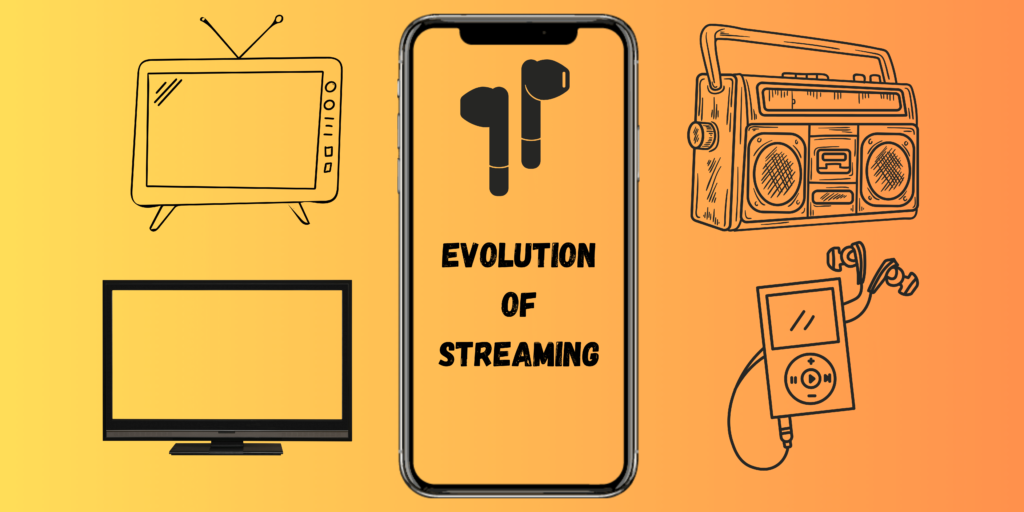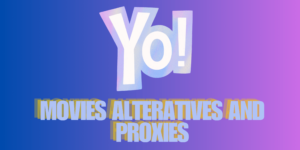We have come far from the times when we had to wait for hours to download a video from the internet. The chances of it being the wrong or a malicious file were also high. Now gone are the days when we tried to illegally download music on the family computer from suspicious websites.
Today, everything is available with the click of a mouse. Platforms like Spotify, Youtube Music, Netflix, and Hulu have changed the way we access content. It is hard to now imagine a world without live and video-on-demand(VOD) streaming.
But do you know how all this came into being? Did you know Netflix started as a DVD-renting business? Or that way before Spotify, there were Napster and Pandora? Intrigued? Check out this article on the evolution of streaming platforms to learn more in-depth about the history of streaming.
Contents
Evolution of Streaming Services Timeline
While streaming services have become ubiquitous these days, do you know their history? Do you remember the time before Netflix and Chill was a thing? Let us trace back the history of streaming platforms here.
1990-2000: Proof of Concept for Streaming
The streaming boom during the pandemic may make it seem like a new thing but the idea of it began back in the nineties. The band Severe Tire Damage was the first to have an audio and video live stream with the help of the MBone technology.
Just a year later in 1995, the Rolling Stones joined Severe Tire Damage to become pioneers of live streaming. ESPN too soon entered the game with live audio streaming of the Seattle Mariners vs. New York Yankees game.
During this time, a number of technologies such as Macromedia(Adobe) Flash Player, Real-Time Messaging Protocol(RTMP), and the Real-Time Streaming Protocol(RTSP) were developed that later became key to the rise of streaming services.
2001-2010: Flash and RTMP
In this era, Adobe Flash practically became synonymous with streaming due to the advancement in compression technologies and the general increase in bandwidth. The concept of internet video gained mass popularity when YouTube was launched in 2005. Justin.tv(which later became Twitch) and Netflix too had begun to take off.
While Adobe Flash was powering around 98% of internet browsers at this time, Steve Jobs criticized it on grounds of being proprietary and announced that the iPhone would use its own proprietary HTTP Live Streaming(HLS) format instead of Flash.
2011-2019: Live Streaming Comes to the Masses
The adoption of HTTP-based technologies had several benefits in terms of both scale and quality. Adaptive streaming helped platforms combat buffering issues and improve caching efficiency. In 2012, MPEG-DASH was developed as an alternative to vendor-specific technologies like Apple HLS, Microsoft Smooth, and Adobe HDS.
After this, YouTube also chose DASH as its protocol after shifting from Flash to HTML5. While live streaming, especially on mobile phones gained more popularity during the 2010s, the problem of latency during broadcasts also increased.
2020-2022: A COVID-19 Fuelled Streaming Boom
Live streaming became ubiquitous as the 2020s came around. During this time, the COVID-19 pandemic forced a global lockdown, and mandated social distancing meant that the majority of entertainment shifted online.
Flash also died that year and broadcasters shifted to Web Real-Time Communications(WebRTC), CMAF for DASH, Low-Latency HLS, and Secure Reliable Transport(SRT) to address latency issues and power interactive content. Apart from streaming movies and TV shows, Zoom meetings, telehealth, digital fitness, and live commerce emerged as use cases of live streaming.
The popularity of streaming did not die even after the pandemic restrictions were loosened. Netflix, Hulu, Disney+, Prime Video, Peacock, etc. provided consumers with a wide variety of choices.
Streaming Wars
As the number of streaming services available increased, a new phenomenon described as the streaming wars emerged. This refers to the competition among OTT platforms to differentiate themselves from the others. Offering exclusive content, often self-produced and created is a key tactic to capture a particular market segment.
This was all the more visible during the COVID-19 pandemic years as people stayed home and turned to the internet and TV to entertain themselves. However, this dispersion of content put consumers at a disadvantage as they were subscribing to multiple services and racking up costs for a medium touted to be an escape from cable and satellite.
The Rise of FAST
During this time of subscription fatigue, a new alternative emerged: FAST or Free ad-supported television. It works like cable TV with its linear, live programming but is available on internet-connected devices. This witnessed exponential growth in 2021 with viewership growing by 103%.
At the same time, companies began exploring more extended reality and metaverse projects such as virtual house tours and 3D gaming as the next-generation video streaming avenues.
After 2023, while the growth of streaming services may not be at the level they were a few years back it is clear that streaming is here to stay.
Rise of Music Streaming
It would not be wrong to say that the internet has completely changed the way we consume music. Remember the days of Napster? It was a peer-to-peer site where people used to share MP3 files of songs for free. People could use it to download songs for free and even access rare live versions, alternate cuts, and demo versions.
However, Napster soon got embroiled in copyright and ownership issues, and the website shut down in 2001. This whole saga made clear that online music sharing was an avenue worth exploring. Therefore, Apple launched its online music library i.e. iTunes Store in 2003. Users could download whole catalogs at the price of $0.99 per song.
Pandora, launched in 2005, was a pioneer in the online music streaming arena as it combined the interface of iTunes with other characteristics such as recommending music based on the user’s history and the ability to bookmark artists. It is the influence behind several modern streaming services such as Spotify.
At the same time, MySpace which was primarily a social media platform helped indie musicians stream their music to interested users for free. While it faded into obscurity by 2009, it played a huge role in popularizing artists like Arctic Monkeys and Lily Allen.
Modern music streaming platforms like Spotify, Apple Music, SoundCloud, and YouTube Music operate under a premium subscription model with some offering freemium services. There is fierce competition in this space too but less than that for video media.
Online streaming has certainly disrupted the music industry with CDs and single-track downloads witnessing a downfall due to content being freely available on the internet. Now, streaming revenue is considered to be one of the biggest factors driving growth in the music industry.
Impact of Streaming Services
Changing Viewing Habits
The rise of streaming platforms has changed the way viewers consume content. The weekly episodic format has given way to the binge-watch method where whole seasons are dropped and devoured in a single weekend. There is a shift towards a more personalized experience as compared to the one-size-fits-all traditional TV model.
Users can curate their content libraries and receive recommendations tailored to their tastes. On-demand streaming has given audiences the flexibility to watch what they want, whenever they want.
Content Boom
Streaming services, particularly Netflix, contributed to a surge in original content production. It heavily invested in original programming across various genres to attract and retain subscribers. Streaming platforms have created high-quality and critically acclaimed movies and TV shows that are at par with traditional studio productions.
This shift has also democratized content creation allowing stories from diverse backgrounds to be told on a global platform.
Cultural Impact
The rise of streaming has also brought about noticeable changes in cultural trends. It has led to a more connected cultural experience as content is produced and distributed globally.
Content from different parts of the world is easily available on streaming platforms and has exposed people to different cultures, traditions, and perspectives. The popularity of Money Heist from Spain, Dark from Germany, and Squid Game from South Korea is an example of this.
Similarly, shows like Black Mirror and The Handmaid’s Tale shed light on societal issues and facilitate conversations about them.
Was Netflix The First Streaming Service?
No, Netflix is not the first streaming service. The crown of being the first video streaming service goes to YouTube which was launched in 2005. Created by Chad Hurley, Steve Chen, and Jawed Karim, it became known to the public in December 2005 when Saturday Night Live(SNL) uploaded its first video shot “Lazy Sunday” on it.
The SNL rap video went viral and introduced the world to video sharing on YouTube. However, the increasing popularity created problems for the platform as it was spending a lot of money on bandwidth expenses with no proper revenue streams.
In 2006, Google acquired YouTube for $1.65 billion in stock, and within months after this, the latter became the second-largest search engine in the world just behind Google itself. Today, over 1.3 billion people use YouTube every month and more than 5 billion videos are watched on it every day.
While Netflix did start operations in 1997, it was a DVD-renting business at that time The founders Reed Hastings and Marc Randolph had already envisioned a website where viewers could order movies with just one click but the technology was not there yet.
Therefore, Netflix ventured into the streaming space only in 2007 and released its first original production House of Cards in 2013. Now many of the most popular shows in the past few years such as Orange is the New Black, Stranger Things, and Bloodline are all Netflix productions.
Conclusion
Streaming has changed the way we seek and consume content. It has enabled us to curate what we watch, given opportunities to new voices, and led to a globalization of trends. Streaming of all types- movies, music, and sports witnessed an unprecedented boom during the pandemic.
While it may not be witnessing growth at the same level, especially due to so many players in the market, one thing is clear- streaming is here to stay. FAST and extended reality projects are extensions of this phenomenon indicating that businesses are already exploring new avenues and opportunities for video streaming.





